|
The Ais Indians, for whom Mission Dolores was intended and named, Nuestra Señora de los Dolores de los Ais, were a relatively small tribe living on the southern fringe of the homeland of the numerous Caddo-speaking groups. Frustratingly little is known about the Ais (also referred to as the Ay, Ays, Ayx, Ayche, Aiche, Aizes, Aies, Aes, Aliche, Ayish, Eyish, Eyeish, Hais, and Haychis). The Ais have been mentioned in documents ever since the first direct European contact in the vicinity of modern day San Augustine, Texas. Mentioned, but never described in depth and never in quite the same way.
It is likely that the Ais spoke a Caddoan language that had diverged from Caddo and other Caddoan languages in the distant past. In addition to their own language, the Ais were said to speak Caddo proper, suggesting that they maintained close relations with their neighbors and linguistic “cousins.”
In the historical record, the Ais were first encountered in 1542 when remnants of the De Soto expedition led by Moscoso, passed through the area. Expedition accounts mention the Ais, and describe them as warlike and very much attached to hunting buffalo. One hundred and forty-five years later the Ais are one of the groups recorded by the Frenchman Henri Joutel in 1687 when he passes through the area as part of the failed colony established by La Salle on the Texas coast (see Fort St. Louis). When the first Spanish missions were established in East Texas in 1690, the Ais were said to be at odds with the Haisinai. In 1699 they were purportedly associated with allied Indian groups under the overall leadership of the Cadohadacho, according to Pierre Le Moyne d’Iberville who learned this information from a Taensas Indian. In 1708, the French were trading for horses with the Ais, and in 1713 St. Denis returned to the area to get more horses from the Ais and other Indian groups.
A mission for the Ais was not initially planned when the Spanish returned to East Texas in 1716—the missions for the Ais and Adaes seem more like afterthoughts, as the visits to these two groups are not recorded in the official diary of the expedition. Father Antonio Margil probably already knew of the Ais and Adaes when he promised to build a mission for them on his way to visit Natchitoches in 1717. More details about the Ais become available after Mission Dolores was initially established in 1717.
The mission was located roughly in the center of eight Ais settlements in the area of the Ayish Bayou. In 1727, Fathers Pedro Muñoz and Joseph Calahorra—both visitors to Mission Dolores—describe the Ais as a “great nation” and relate that even though no Ais were living at the mission, baptisms had been administered since 1717. The baptisms are described as in articulo mortis, or at the point of death—that is, just before death. Pedro Rivera, leader of the military inspections at Presidios Dolores and Adaes observed the following in 1727:
The eight tribes living in the area—the Adays, Ays, Nacodoches, Aynays, Nazones, Nechas, Naconomes, and Navidachos—are all docile and peace-loving in nature. Although the French have furnished them with firearms, with which the Indians are proficient, they nonetheless respect mounted and armed soldiers. The submission shown to the soldiers evidences the calm nature of the Indians.
– Naylor and Polzer 1988:157
The Ais were among the Indian groups who came to the aid of the French, along with soldiers from Los Adaes, when the Natchez attacked Fort St. Jean Baptiste at Natchitoches in 1731.
Father Ygnacio Cyprián of Mission Dolores wrote a letter with a report in 1749. Cyprián relates that there are 70 families of Ais located in eight settlements within two leagues (just over five miles) of the mission. Starting around 1740, Cyprián was successful in congregating some of the Ais at the mission, but when supplies ran out, the Ais returned to their villages. That the Ais actually settled at the mission is a most unusual occurrence for the Spanish missions of the piney woods. Cyprián reports baptisms in articulo mortis, but he is particularly upset that that three Ais children who were baptized alive in 1731, subsequently turned to a life of apostasy and died as apostates. Cyprián states that it was the Ais tribe that made the baptized children return to idolatry and implies that baptizing children may not be such a good idea since it creates an undue strain on the children. In 1754, there had been 158 baptisms recorded at Mission Dolores.
An inspection of the East Texas missions by Father Gaspar de Solís in 1767-68 provides one of the most detailed accounts of the mission and the Ais.
The Indians of the Ays Nation came with their captain whom they called Urjataña. I asked them by means of an interpreter if they wished to congregate themselves and live with the Fathers in the mission. They replied that they did not, and this I judge improbable in their present condition. They danced in their heathenish manner with extraordinary and unusual ceremony and grimaces.…
The Indians of this Ays Nation are the worst of this Province: drunkards, thieves, given to mitotes and dances, and to all kinds of vice, principally that of licentiousness. They are idle, overly audacious, shameless. They have lost respect for many of the Religious in work and deed, even laying their hands on them. ─ Solís 1931:66-67.
In the early 1770s, shortly before the mission was closed, a French trader, Athanase De Mézières reported that the Ais numbered only 30 men, which probably meant a total population of around 120. In 1776 De Mézières reported that the Ais are “almost extinct as a nation; four years ago the small pox destroyed the greater of them.” And in 1779 he relates that the surviving Ais were hated by both their Spanish and Indian neighbors. In 1795, Ais Indians accompany Antonio Leal to La Bahia to ask for another mission—this request is refused and the Ais are settled on the Brazos River. John Sibley, the U.S. Indian Agent living in Natchitoches implies that in 1806 the Ais had moved from the Ayish Bayou, which was then occupied by a few French and American families. Sibley said of the Ais, “their native language is spoken by no other nation; but they speak and understand Caddo, with whom they are in amity, often visiting one another.”
In 1820, the Ais are described as living near the Attoyac River, although it is more likely that the Ais were living near the Brazos at this time. Concerning the Ais, Juan Antonio Padilla’s report relates, “They are very much like the Cadó, differing from them only in language and in the manner of shaving their heads. They number about three hundred Indians. They pierce their noses and paint their faces with vermillion. They are fond of the Spaniards.” The 1828 census reports 160 Ais families, quite a large number, and indicates that they lived between the Brazos and Colorado Rivers. In 1830, Jean Louis Berlandier echoes Padilla and relates that the Ais “. . . very much resemble the Cado, except for the tattoos on their noses and the way they shave their heads.” By 1837, the Report of the Standing Committee on Indian Affairs relates that the Ais and Nacogdoche are living dispersed among the Caddo, Inoni (formerly Hainai) and Anadarko (formerly Nadaco).
There is very much a mixed picture related to how well the Ais got along with the Spanish and other Indian groups, and perhaps, this is the way it actually was—sometimes the Ais got along well with others, and sometimes they didn’t. John Swanton, author of the most comprehensive survey of documents related to the Caddo, sums it up as follows:
Part of the secret of their disreputable character is probably to be found in the circumstance that they were a small tribe with a peculiar dialect of Caddo and a relatively undeveloped culture. For this reason, without doubt, they were looked down upon by other Caddo before any mission was established among them —Swanton 1996:126
One thing is certain, the Ais were most definitely politically tied to the Hasinai and Kadohadacho, even if they were somewhat different culturally. In the 1700s and early 1800s the Ais are mentioned with Hasinai groups (i.e. Nabedache, Nacogdoches, Hainai) in dealings with the French, as part of military operations against the Spanish, and as part of political dealings with the Americans. In 1896, The Ais were remembered by the Caddo as one of the 12 affiliated groups that came to Oklahoma, and Cecil Carter relates that “Aays or Hais (in some later records spelled Ais, Haish, or Eyeish) is a name still familiar to Caddo people” (Carter 1995:364). A Hasinai chief who rose to prominence in the 1800s was named Aasch (also Aash, Iesh—the Mexicans and Americans called him José María) and he led the Caddo and affiliated groups out of Texas to Oklahoma in 1859.
Aboriginal Artifacts at Mission Dolores
American Indian pottery dominates the archaeological assemblage from Mission Dolores as over 90% of pottery sherds (13,013 out of 14,091 sherds) are from aboriginal pottery vessels. This is the pattern at many of the Spanish missions in Texas, which is to be expected because substantial populations of Indians lived at many of the the missions. But the pattern at Mission Dolores is somewhat surprising because Indian populations, for the most part, did not live at the east Texas missions. Clearly there was a great deal of interaction between the Spanish at Dolores and the nearby American Indians, presumably the Ais. Some of the aboriginal pottery has European influences, especially shallow brimmed bowls that would have looked like soup bowls, but most is indistinguishable from the early historic Indian pottery found at many sites in the region.
Some of the aboriginal pottery sherds at Mission Dolores have different patterns of incised or engraved lines and punctates, but most—roughly 90%—have a plain surface. The most common named pottery type is Natchitoches Engraved; other types include Patton Engraved and Emory Punctated. The small white specks seen in most of the pottery sherds at Mission Dolores are fragments of burnt bone added as “temper” to reduce the amount of shrinkage during drying and firing of the vessel. Less commonly, crushed fragments of burnt shell temper were added.
The pottery assemblage from Mission Dolores is similar to Los Adaes, although for some pottery types, such as Ebarb Incised—the Los Adaes examples are shell-tempered while the Mission Dolores examples are bone-tempered. Pottery sherds with a brushed surface treatment are notably lacking at Mission Dolores. Brushed sherds are common at the Spradley Site (41NA206), a Nacogdoche village site located about three miles south of Nacogdoches, and other historical period Indian sites in the area. Brushed sherds are absent at Los Adaes. The general lack of brushed sherds at Mission Dolores and Los Adaes may be a pottery attribute associated with the Ais and Adaes during the 18th century.
Jim Corbin suggested that the pottery recovered from Mission Dolores can be distinguished from pottery recovered from other archaeological sites of the 18th century in the region, and refers to it as the Ais Constituent Group. It is similar to the Adai Constituent Group found at Mission San Miguel de Cuellar de los Adaes. The aboriginal pottery found at both missions includes the Natchitoches Engraved and Emory Punctated types with similar designs, except differing in predominate temper – bone at Mission Dolores and shell at Los Adaes.
Another category of Indian artifacts found at Mission Dolores is projectile points. Some are Archaic dart points that reflect much earlier use of the area along Ais Bayou. Most, however, are small triangular projectile points that are true arrow heads of the style commonly found at Spanish Colonial sites in Texas. These arrow points are made of chert (flint) and less commonly glass. While it is likely that the Ais Indians made and used most of the arrow points found at Mission Dolores, identical points were also made by other American Indian groups in Spanish Colonial Texas, and may also have been used by Indians who served as soldiers and scouts in the Spanish military. |
 This section of a 1756 hand-colored version of a 1755 map by British cartographer John Mitchell shows the location of “Ayches” just north of an east-west road, the Camino Real de los Tejas. See John Mitchell 1755 to learn more about this map  |
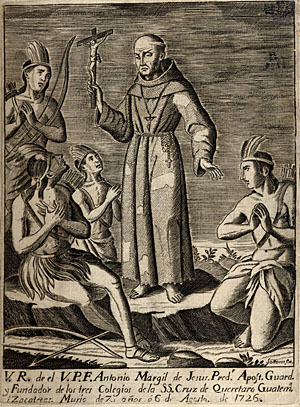 Father Antonio Margil as depicted in the book "The Exemplary Life of the Venerable Father Friar Antonio Margil de Jesus" written by Isidro Felix de Espinosa in the mid-1700s. Source: Digital Collections, Ralph W. Steen Library, Stephen F. Austin State University.  |
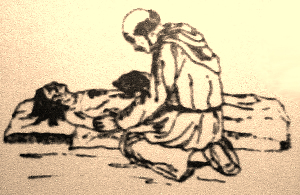
The priests at Mission Dolores came to prefer baptizing in articulo mortis, or just before death (literally at the point of death). If children were baptized might return to their non-Christian ways and die as apostates, but if individuals were baptized just before death, they wouldn’t die as apostates … |
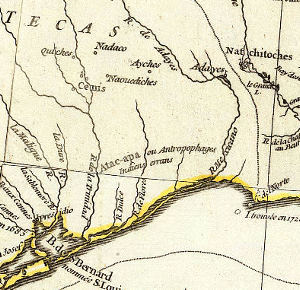
Portion of 1763 map by Jean Baptiste Bourguignon Anville showing the “Ayches”(Ais) between (Presidio Los) Adaes and Naouediches (Nacogdoches). See Jean Baptiste Bourguignond'Anville 1732 to learn more about this map.  |

Rim sherds from aboriginal pottery has European influences, especially shallow brimmed bowls that would have looked like soup bowls. Photograph by Andrea Locke. Enlarge to see more specimens.  |
|
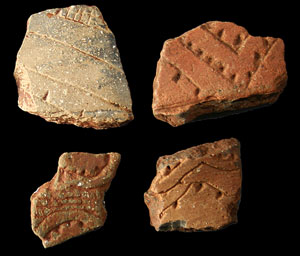
Natchitoches Engraved is the most common pottery type found at Mission Dolores. This type is often found at early historic period Caddo Indian sites in the region, but were likely made by related groups such as the Ais and the Adai. The small white specks are fragments of burnt bone added to the paste as temper. Photograph by George Avery. Enlarge to see more specimens.  |
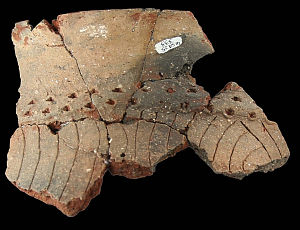
Partially reconstructed rim of an Emory Punctated earthenware jar. This style has a ring of punctates around the vessel neck and curvilinear incised lines on the body. Photograph by George Avery.  |
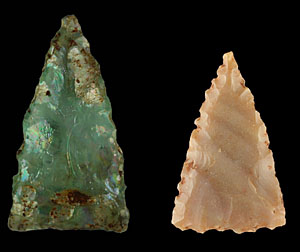
Small triangular arrow points from Mission Dolores. The one on the left is made from bottle glass, while the others are made from chert (flint). Photograph by George Avery. Enlarge to see more specimens.  |
|







